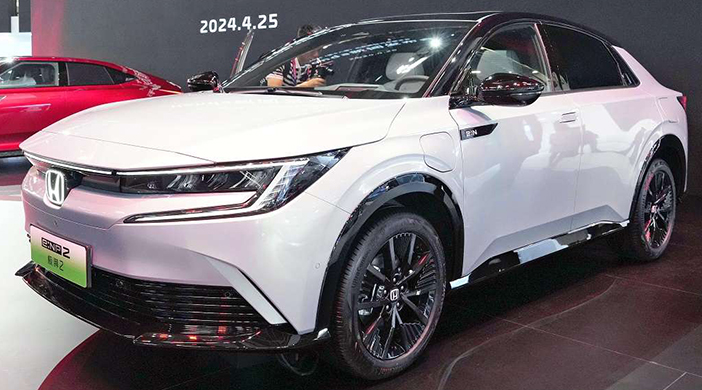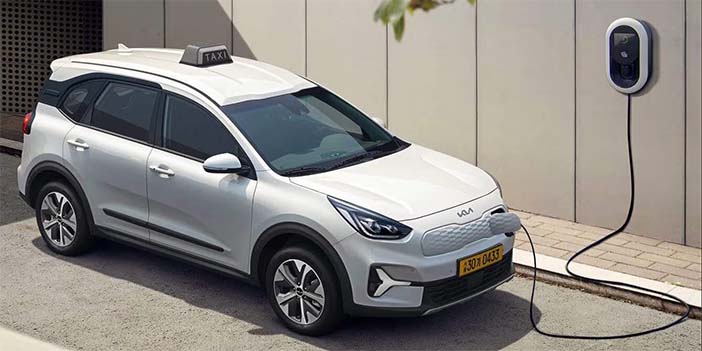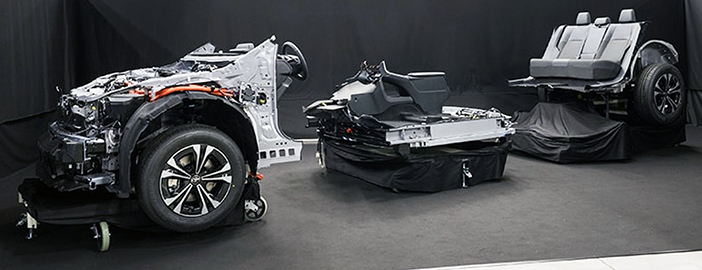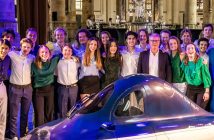+++ The HYUNDAI MOTOR GROUP will invest 1.29 trillion won ($946 million) in Motional, a US-based autonomous driving startup, to boost technological development and secure stable control of the startup, the Korean auto conglomerate said Friday. The Hyundai Motor will spend 663 billion won in capital increase and another 620 billion won for acquiring Aptiv’s 11 percent share in Motional, bringing the auto giant’s total share to 66.8 percent. The auto giant’s 3 affiliates (Hyundai Motor, Kia and Hyundai Mobis) will take part in the capital increase. They will spend 665 billion won, 361 billion won and 257 billion won, respectively. The transactions are expected to be completed by the third quarter of this year, according to Aptiv’s first-quarter earnings report. Hyundai Motor and Aptiv, an Irish-American automotive technology company, each invested $2 billion to establish Motional as an equal joint venture in March 2020. Motional has focused on developing and commercializing Level 4 high automation, which means practically self-driving vehicles. “The additional investment is expected to enhance Motional’s technological competitiveness by establishing the direction of technology development and lay the groundwork for expanding synergy between autonomous driving units within the Hyundai Motor Group”, said an official. Motional, however, continues to turn in losses as the development of autonomous driving technology has yet to find a commercial breakthrough. According to the business reports of Hyundai Motor Group’s affiliates, the startup’s accumulated operating losses have amounted to about 2 trillion won over the last 3 years. Aptiv previously announced during its fourth-quarter earnings conference in January that it would no longer allocate capital to Motional and that it would pursue alternatives to cut down its ownership share, as the autonomous driving startup has continued to bleed. The latest disclosed information on Motional’s level of technology is that it could pass a US driver’s license test, as Hyundai released a campaign film showing the all-electric, self-driving Ioniq 5 robottaxi passing a simulated testing process in March. The video showed the car smoothly navigating the Las Vegas Strip and the city’s suburban areas. “The Hyundai Motor’s additional investment in Motional shows its commitment to autonomous driving technology at a time when the short-term future of self-driving vehicles is not looking so bright”, said an auto industry analyst at a local securities firm. “But having a majority stake in Motional will allow Hyundai to make decisions faster and change directions quickly. Although questions will remain until Hyundai can show tangible results, the company is unshaken by the additional financial spending because its main business of selling cars is going well”. +++
+++ Companies from JAPAN participating in the 2024 Beijing International Automotive Exhibition were emphasizing discounts and cheap prices. Automakers from this country are struggling with a price war that has intensified due to the overproduction of electric and other vehicles as well as the real estate recession in China. When the world’s leading auto show opened on Thursday, Honda launched the its new EV model, the e:NP2, in China (photo). At the exhibition venue, a senior official of a joint venture company announced the vehicle was priced at 189.800 yuan. The official then said that there would be a 30.000 yuan discount for the time being, which triggered applause from the audience of several hundreds of people. Lowering the price of a new model at the same time as its launch is unusual even in China. Compared to the previous model that was launched 2 years ago, the range of the new model is 7% further and it is equipped with better information technology functions. Even still, the company lowered its price. An official explained, “Setting the price was quite tough but the company has no choice but to start by offering a discount to catch customers’ attention”. Lei Jun, the chief executive officer of major smartphone company Xiaomi, which has recently entered the EV market, proudly announced Thursday that the company has received more than 75.000 orders. Xiaomi’s first EV model, the SU7, which was launched at the end of March, is priced at 215.900 yuan. While it is said that the company will lose money on each unit it sells, it is expected to prioritize expanding its market share over profits for the time being. Tesla and China’s largest EV company BYD further lowered prices of their vehicles to vie with such companies. This year’s exhibition is the first since 2020 as it had been canceled during the Covid pandemic. At this year’s event, 278 new energy vehicles including EVs were on display, up 70% from the 160 displayed 4 years ago. According to Chinese media, the Chinese EV market is in fierce low-price competition and the scale of price cuts in the first quarter of the year reached the same level as the entirety of 2022. Behind this situation is the increasing imbalance between production and sales. Auto production in China reached 30.16 million units in 2023, up 11.6% from the previous year. On the other hand, the real estate recession has been lengthy and the government’s subsidies for new energy vehicles were ended at the end of 2022. The demand for automobiles in China peaked at 29.12 million units in 2017 and stood at 25.98 million units in 2023. Oversupply makes it difficult to sell vehicles without large discounts. China’s auto exports in 2023 amounted to 4.91 million units, making it the world’s largest auto exporter, overtaking Japan. This is possibly because China exports automobiles that failed to sell domestically. Over the 3 years of the Covid-19 pandemic, Japanese automakers fell far behind in terms of the electrification of vehicles and the use of information technology, both of which progressed rapidly in China. Toyota, Honda and Nissan all saw year-on-year sales decline in China, ranging from 1.7% to 16.1%. These companies are struggling to make up for the delay and are taking such measures as increasing the lineup of new energy vehicles and signing business partnerships with major tech companies such as Tencent and Baidu. Mazda president Masahiro Moro showed a cautious attitude over joining the price war, saying: “The entry of many start-up manufacturers into the EV market has led to price collapse. However, I believe prices will settle out to sustainable levels in the medium term”. +++

+++ KIA will discontinue production of its first purpose-built vehicle (PBV), the Niro Plus, in October. According to automotive industry reports, Donghee Auto, the manufacturer of the Niro Plus, has recently notified its suppliers that it will cease production of the vehicle in October to prevent the accumulation of unused inventory. The company is a joint venture between Kia and the parts company Donghee Holdings, and it manufactures the Niro Plus along with other models such as the Stonic and Picanto. Launched in 2022, the Niro Plus is an electric taxi based on the first-generation Niro EV. Although the Niro EV transitioned to the second generation that same year, the Niro Plus has only been sold as a derivative of the first generation. It features a 64.0 kWh battery that allows a maximum range of 392 km on a single charge and includes a taxi-specific infotainment system with an integrated meter on the central screen. The decision to discontinue the Niro Plus seems to be due to decreasing sales: 4.713 units were sold within 8 months of its launch in May 2022, but sales dropped to 2.916 units last year and only 88 units were sold in the first quarter of this year. Electric taxis have also been affected by the slowdown in the EV market. According to CarIsYou Data Lab, the number of newly registered electric taxis last year totaled 12.552; a 20.4% decrease from the previous year’s 15.765. The current electric taxis on the market in South Korea include Hyundai’s Ioniq 5 plus Ioniq 6, and Kia EV6 plus Niro Plus, with the Ioniq 5 accounting for about half of all electric taxi sales. This year, the reintroduction of liquefied petroleum gas (LPG) taxis has further narrowed the market for electric taxis. Hyundai discontinued the 7th generation Sonata New Rise LPG taxi in July last year due to deteriorating profitability, but relaunched it earlier this month as the 8th generation The Edge following industry backlash over the lack of alternatives. Kia is also reportedly considering relaunching the discontinued K5 (Optima) LPG taxi from 2021. Given that the Niro Plus is based on the Niro EV, it may potentially be released as a new model in the future. The Niro is expected to undergo a facelift next year. +++

+++ POLESTAR will delay the publication of its fourth-quarter and full-year 2023 financial results for a second time, a spokesperson for the company said. The Chinese-Swedish electric-vehicle maker did not provide a date for the release but said it still intends to publish first-quarter financial results on May 23. The delay is partly because the company needs more time to finalize its financial statements over accounting misstatements in 2021 and 2022 that will be rectified in the 2023 report. As a result of the restatements, the company expects its net loss to decrease by less than 5% for 2021 and increase by less than 5% for 2022. Polestar also requires more time to complete work related to the internal control of its financial reporting as per the Sarbanes-Oxley Act of 2002, the spokesperson said. Sarbanes-Oxley is a law which created enhanced accounting standards for publicly traded U.S. companies after a series of accounting scandals. Polestar was initially set to report its 4th quarter results on February 29, before postponing it to April 23. The company reported a 40% drop in first-quarter deliveries earlier this month as slowing demand due to uncertain economic conditions pinched consumer budgets and prompted them to cut back on big-ticket purchases. +++
+++ RENAULT KOREA is moving to reshape its brand identity targeting the younger generation here by launching its long-awaited new hybrid SUV and deepening communication, particularly with those in their 20s and 30s, the automaker said. Under its group-wide motto of Nouvelle Vague, which is French for “new wave,” the company is rebuilding its corporate vision. Firstly, the company decided to apply its Losange emblem for its flagship models (such as QM6) as part of its efforts to offer fresh and sophisticated mobility experiences to customers, the company said. The company also introduced its Electro Pop strategy here whose 3 key themes include its E-Tech electrification technology, cutting-edge connectivity and human-first safety. The company aims to offer a blend of European style and cutting-edge technology tailored to a younger clientele. The local subsidiary of the French automaker is placing its strategic focus on this demographic, as their purchasing power is on the gradual rise here. Targeting them, the automaker also opened its Renault Seongsu flagship store in Seoul, enabling them to test-drive its vehicles and get a better grasp of the brand. “Renault’s brand is starting anew in Korea”, an official said. “We will strengthen details in every corner of our businesses, including products and services, so we can deliver our brand-new values to customers”. Renault Korea will unveil the much-anticipated mid-sized hybrid SUV for the first time in June during the upcoming 2024 Busan International Mobility Show. The vehicle is better known by its project name, the Aurora 1. The automaker also plans to release the Aurora 2, a mid-sized hybrid car sometime next year. The pinnacle of its Electro Pop vision is the Aurora 3: the automaker’s new electric vehicle (EV) whose launch is scheduled for 2026. Earlier, Renault shared its mega investment plan worth 1.5 trillion won ($1.08 billion) by 2027 here to complete the vision for future mobility. Renault Korea is also moving to reshape its brand identity for existing models. The formerly XM3 compact SUV will be sold under the new name of Arkana, and will be equipped with its new emblem. The firm’s best-selling QM6, a SUV, will also be equipped with the company’s new emblem. +++
+++ In SOUTH KOREA , Ford and Jeep are expected to be hit hard by the strengthening dollar, as U.S. automakers settle their payments with the greenback unlike European or Japanese counterparts, according to industry officials, Thursday. This adds more financial pressure on the 2 local subsidiaries of the U.S. carmakers, as their market share and vehicle sales are plummeting in the Korean market. Considering the weak consumer sentiment toward U.S. cars, they are not in a position to raise their vehicle prices to make up for the potential loss from the rising value of the dollar against the Korean won. This is not the case for other European automakers that settle their payments either with the Korean won or the euro, leaving them relatively less influenced by the strengthening dollar. Officials from carmakers here and abroad are expressing concerns that customers may end up falling victim in the end. “If imported vehicle prices increase in line with the rising dollar, sellers may reduce incentives or services provided to customers, as they have to ensure their profitability”, an official from a carmaker said. “It will be hard for them to increase their vehicle price by a huge margin at a time when they lose more and more presence here amid toughening market rivalry”. Ford Korea reported a sales decline of 30 percent in 2023 from a year earlier. It also turned into an operating loss of 4.9 billion won ($3.56 million) during the same period. Ford car sales also hit a new low of 3.483 last year, down 35.2 percent from the previous year. Reflecting on the dismal sales performance, Ford is rumored to exit the Korean market around the end of this year, though the company has declined to make any comment on the issue. Jeep sold 4.512 vehicles in South Korea in 2023; down 37 percent from a year earlier. Another official from an imported automaker said U.S. carmakers will have no clear breakthrough to tackle the ongoing challenges. “The falling sales and the macroeconomic uncertainty, represented by the rising dollar, will dampen their year-end earnings result”, the official said. “Given the unfavorable car market sentiment, they will not be able to raise their vehicle prices”. +++
+++ TESLA has backed away from an ambitious plan for innovations in Gigacasting, its pioneering manufacturing process, according to 2 sources familiar with the matter, in another sign that the electric-vehicle maker is retrenching amid falling sales and rising competition. Tesla has been a leader in Gigacasting, a cutting-edge technique that uses huge presses with thousands of tons of clamping pressure to die-cast large sections of the car’s underbody. On a typical vehicle, the underbody can consist of hundreds of individual parts. Last year, as Tesla developed a new small-vehicle platform, it aimed to punch out the underbody in a single piece. The long-term goal was to radically simplify manufacturing and slash costs. But Tesla has since halted the effort, opting to stick with its more proven method of casting vehicle underbodies in 3 pieces: 2 Gigacasted front and rear sections and a midsection made of aluminum and steel frames to store batteries, according to 2 sources familiar with the matter. That is largely the same 3-piece method the company has used for its past 2 models, the Model Y and the Cybertruck. Tesla’s retreat from 1-piece Gigacasting has not been previously reported. The decision to hold off on the potential manufacturing breakthrough marks another example of Tesla slashing short-term spending as it adjusts to falling sales and profit margins, softening EV demand globally, and intensifying competition from rival EV makers such as China’s BYD. Tesla last month laid off more than 10% of its global workforce. A handful of senior executives have also resigned or been pushed out. Such moves also reflect a fundamental strategy shift, with Tesla now focusing more on developing self-driving vehicles than on pushing for huge growth in EV sales volume, which many investors had been counting on. The step-back on Gigacasting occurred last autumn, the people said, before Tesla decided in late February to halt development of an all-new affordable car, often called the Model 2, which would have been the first vehicle it built with 1-piece Gigacasting. Cancellation of the Model 2 was reported by Autointernationaal.nl early in April. On April 23 however, as it released earnings that missed Wall Street expectations, Tesla said it had a simpler, faster plan for producing “more affordable” cars after shelving plans for the Model 2, which was expected to cost $25.000 and be released in the second half of 2025. Instead, officials said, it would produce affordable models using a current platform and production lines. On an investor call, chief executive Elon Musk declined to provide details on the planned new offerings or their target prices. Tesla has not entirely abandoned the small-vehicle platform it had planned for the Model 2. Instead, it will move forward in developing a self-driving robottaxi on the same platform. 1 of the 2 sources familiar with the automaker’s Gigacasting operations said the suppliers involved are now adapting Tesla’s 3-piece process for the next-generation vehicle. Both sources said the automaker decided last autumn to halt work on the more innovative and difficult 1-piece casting process. At the time, the rationale for the decision was to speed development of the now-defunct Model 2 and avoid any costly delays or manufacturing problems, the 2 sources said. Tesla and Musk have said Gigacasting helps the automaker reduce costs over the long term. But the process requires large initial investments and is difficult and time-consuming to perfect, automotive manufacturing experts say. Experts in vehicle manufacturing said Tesla’s more conservative path on Gigacasting is no surprise and in part reflects the pains it has experienced historically in launching complex and innovative vehicles on time. The automaker’s highly experimental Cybertruck arrived last autumn at a far higher price than predicted after substantial delays to work through manufacturing issues. Tesla is still struggling to produce the angular, stainless-steel pickup in mass-market volumes. Holding off on one-piece gigacasting will save the company from making massive short-term capital investments in manufacturing and design, said Terry Woychowski, president of U.S. engineering company Caresoft Global, who has led teardowns and engineering analyses on numerous vehicles, including Teslas. “Would they rather have done it all in one big piece? Sure, they would’ve, but at what cost?” Woychowski asked. James Womack, a vehicle manufacturing expert and former research director at the Massachusetts Institute of Technology, said Tesla’s Gigacasting pullback reflects the company’s scramble last year to launch an all-new $25.000 car to catch up with Chinese EV makers who are already dominating the low-cost EV segment. But pushing forward with an innovative production technique would do little to help sell a Tesla car to consumers, Womack said. “It’s not very exciting from the standpoint of the public and buyer”, Womack said, “and you don’t know whether this is really a big cost-saver or not”. +++

+++ An assembly plant to produce TOYOTA vehicles has opened in the Phnom Penh Special Economic Zone. At an opening ceremony on Thursday for the factory, Cambodian prime minister Hun Manet said: “Toyota is a giant company. When the giant comes to Cambodia with trust, many other companies will follow suit. Cambodia needs this kind of investment”. The factory, operated by a Cambodian arm of Toyota Tsusho, a group company under the Japanese automaker, will produce Hilux pickup trucks and Fortuner SUVs. Toyota Tsusho CEO Ichiro Kashitani said his company “will continue to promote its business in Cambodia, aiming to contribute to the happiness of the Cambodian people by realizing carbon neutrality and fostering human resources”. Toyota Tsusho Manufacturing (Cambodia) Co is 90 percent owned by Toyota Tsusho, with local Cambodian partner Kong Nuon Group Co holding the remaining 10 percent. +++


